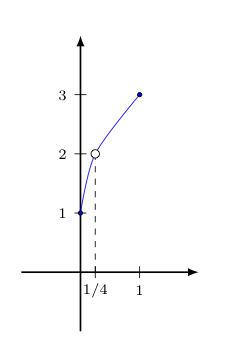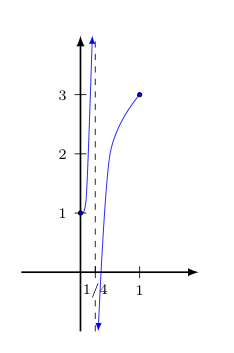

 |  |
Determine if the Intermediate Value Theorem (IVT) applies to the given function, interval, and height $k$. If the IVT does apply, state the corresponding conclusion; if not, determine whether the conclusion is true anyways.
$f(\theta) = 3 + 2 \sin \theta$; $[\pi/6,\pi]$; $k=1$
The IVT will apply if $f(\theta)$ is continuous on $[\pi/6,\pi]$ and $k=1$ is between $f(\pi/6)$ and $f(\pi)$.
With regard to the first condition, note that $f(\theta)$ is continuous everywhere being the composition of a continuous polynomial function $3 + 2x$ and the continuous function $\sin x$. Thus, $f(\theta)$ is certainly continuous on the interval $[\pi/6,\pi]$.
With regard to the second condition, note that $f(\pi/6) = 3 + 2 \sin (\pi/6) = 4$ and $f(\pi) = 3 + 2 \sin (\pi) = 3$. As such, $k=1$ is not between $f(\pi/6)$ and $f(\pi)$.
As the second condition failed to hold, the Intermediate Value Theorem does not apply.
Had it applied, its conclusion would have been there is a value $c$ in $(\pi/6,\pi)$ where $f(c) = 1$. Even though the Intermediate Value doesn't guarantee this conclusion through its application, it may still be that this is the case. To determine if it is, we need to see if we can find a $c$ that satisfies
$$3 + 2 \sin c = 1$$Of course, solving for $c$ we quickly find $\sin c = -1$, which leads to several values of $c$ that make this equation true. In particular, $c = -\pi/2 + 2\pi n$ where $n$ is any integer, is a solution. However, none of these are in the interval $(\pi/6,\pi)$, so the conclusion of the IVT is not true for this function, interval, and value of $k$.
Determine if the Intermediate Value Theorem (IVT) applies to the given function, interval, and height $k$. If the IVT does apply, state the corresponding conclusion; if not, determine whether the conclusion is true anyways.
$\displaystyle{f(x) = \left\{\begin{array}{ll} x & \textrm{ if } x \lt 2\\ 7-x & \textrm{ if } x \ge 2 \end{array} \right.; \quad [0,4]; \quad k=2}$
The IVT will apply if $f(x)$ is continuous on $[0,4]$ and $k = 2$ is between $f(0)$ and $f(4)$.
With regard to the first condition, note that $f$ is continuous everywhere except $x=2$, where there is a non-removable gap discontinuity from $(2,2)$ to $(2,5)$. Unfortunately, this discontinuity is in the interval $[0,4]$ and thus $f(x)$ is not continuous on $[0,4]$.
With the first condition failing, there is no need to check the second. The IVT does not apply in this situation.
Had the IVT applied, its conclusion would have been that there is a value $c$ in $(0,4)$ where $f(c) = 2$. Even though the IVT doesn't guarantee this happens, it may still be the case.
Note that the "top piece" $x$ takes on the value $2$ at $x=2$. However, $x=2$ is not a value relevant to the "top piece", which applies only if $x \lt 2$.
The "bottom piece" $7-x$ takes on the value $2$ at $x=5$. While this value is attained by the bottom piece since $x = 5$ satisfies the condition on that piece of $x \ge 2$, it does so outside of the interval $(0,4)$.
Alas, this means that the conclusion of the IVT simply doesn't hold at all.
Determine if the Intermediate Value Theorem (IVT) applies to the given function, interval, and height $k$. If the IVT does apply, state the corresponding conclusion; if not, determine whether the conclusion is true anyways.
$\displaystyle{f(t) = \left\{\begin{array}{ll} t & \textrm{ if } t \lt 2\\ 5-t & \textrm{ if } t \ge 2 \end{array} \right.; \quad [0,4]; \quad k=2}$
The IVT will apply if $f(t)$ is continuous on $[0,4]$ and $k = 2$ is between $f(0)$ and $f(4)$.
With regard to the first condition, note that $f$ is continuous everywhere except $t=2$, where there is a non-removable gap discontinuity from $(2,2)$ to $(2,3)$. Unfortunately, this discontinuity is in the interval $[0,4]$ and thus $f(t)$ is not continuous on $[0,4]$.
With the first condition failing, there is no need to check the second. The IVT does not apply in this situation.
Had the IVT applied, its conclusion would have been that there is a value $c$ in $(0,4)$ where $f(c) = 2$. Even though the IVT doesn't guarantee this happens, it may still be the case.
Note that the "top piece" $t$ takes on the value $2$ at $t=2$. However, $t=2$ is not a value relevant to the "top piece", which applies only if $t \lt 2$.
The "bottom piece" $5-t$ takes on the value $2$ at $t=3$. As this value of $t$ is in the $(0,4)$, the conclusion of the IVT does indeed hold, despite the IVT not itself applying in this situation.
Show that $x^3 + 2x - 1$ has a root in the interval $[0,1]$.
That is to say, show there is some value $c$ in this interval where $f(c) = 0$, for $f(x) = x^3 + 2x - 1$.
Note $f(x) = x^3 + 2x - 1$ is continuous everywhere as it is a polynomial function; thus, $f(x)$ is clearly continuous on $[0,1]$.
Further, $f(0) = -1$ and $f(1) = 2$, and $-1 \lt 0 \lt 2$.
As such, the Intermediate Value Theorem applies to $f(x)$, the interval $[0,1]$, and height $k=0$. It concludes that there must exist some $c$ in $(0,1)$ where $f(c)=0$. Consequently, $c$ is a root of $f(x)$ in $[0,1]$ whose existence we have now proven.
Show that $x^4 + 3x + 1$ has at least two roots.
Note that $f(x) = x^4 + 3x + 1$ is continuous everywhere as it is a polynomial function; thus, $f(x)$ will be continuous on any closed interval we consider.
Further, $f(-2) = 11$, $f(-1) = -1$, $f(1) = 5$. This gives us two intervals for which we can consider an application of the Intermediate Value Theorem (IVT).
First we consider the interval $[-2,-1]$, noting that $-1 \lt 0 \lt 11$ -- so $0$ is between $f(-2)$ and $f(-1)$. As $f(x)$ must be continuous on $[-2,-1]$ by our earlier argument, the IVT applies and concludes there must be some $c_1$ in $(-2,-1)$ where $f(c_1) = 0$. In other words, this $c_1$ which is guaranteed to exist by the IVT is one root of the polynomial in question.
However we can also look at the interval $[-1,1]$, noting that $-1 \lt 0 \lt 5$ -- so $0$ is between $f(-1)$ and $f(1)$. As $f(x)$ must also be continuous on $[-1,1]$ per our earlier argument, the IVT applies and concludes there must be some $c_2$ in $(-1,1)$ where $f(c_2) = 0$. Consequently, we know of the existence of a second root of the polynomial in question. (Notably, $c_2$ and $c_1$ must be distinct, as they lie in two intervals that share no common points.)
Thus, $x^4 + 3x + 1$ has at least two roots.
Suppose $f(x)$ is continuous on $[0,1]$ except at $x=1/4$, and that $f(0) = 1$ and $f(1) = 3$. Let $k=2$ be a value the function may or may not attain. Sketch two graphs satisfying these conditions -- one where the Intermediate Value Theorem does not apply and the conclusion of the theorem does not hold, and the other where the Intermediate Value Theorem does not apply, but the conclusion of the theorem still holds. (Recall, the conclusion of the theorem in this case is that there is a point $c$ in $(0,1)$ where $f(c) = 2$.
Answers vary, but below are two possibilities. The Intermediate Value Theorem (IVT) does not apply in either case due to a discontinuity at $x=1/4$.
On the left, the conclusion of the IVT fails to be true in any case, as the function never attains a height of $2$.
On the right, even though it is not guaranteed since the IVT did not apply, the conclusion of the IVT still holds true -- there is a $c$ somewhere in $(0,1)$ where $f(c)=2$. In the graph drawn, it appears there are actually two such values for $c$ -- one at about $1/8$, the other just a little larger than $1/4$.


Discuss the discontinuities of $\displaystyle{g(x) = \left\{ \begin{array}{cc} |x+2| & x \lt -1\\ 0 & x = -1\\ x^2 & -1 \lt x \lt 1\\ \cos(\pi x) & x \ge 1 \end{array} \right.}$
All of the functions used in the individual "pieces" are continuous everywhere, so it remains to see if the function is continuous at the "borders" between these "pieces".
As such, we consider the border values $x=-1$ and $x=1$:
At $x = -1$:
$$\lim_{x \rightarrow -1^-} f(x) = \lim_{x \rightarrow -1^-} |x+2| = 1$$ $$f(-1) = 0$$ $$\lim_{x \rightarrow -1^+} f(x) = \lim_{x \rightarrow -1^+} x^2 = 1$$Since the left and right limits agree, $\displaystyle{\lim_{x \rightarrow -1} f(x) = 1}$. However, since this limiting value disagrees with $f(-1)=0$, we have a removable discontinuity that manifests as a hole at $(-1,1)$ with an isolated point at $(-1,0)$.
At $x = 1$:
$$\lim_{x \rightarrow 1^-} f(x) = \lim_{x \rightarrow 1^-} x^2 = 1$$ $$f(1) = \cos(\pi) = -1$$ $$\lim_{x \rightarrow 1^+} f(x) = \lim_{x \rightarrow 1^+} \cos(\pi x) = -1$$Since the left and right limits disagree, $\displaystyle{\lim_{x \rightarrow 1} f(x)}$ does not exist, and we have a non-removable gap discontinuity from $(1,-1)$ to $(1,1)$.
Find the value of the limit $\displaystyle{\lim_{x \rightarrow e} \frac{(\ln x)^2 + 6\ln x - 7}{1 - \ln x}}$ and provide a graphical interpretation.
Graphically, as the function in question was undefined at $x=e$ but the limit as $x \rightarrow e$ existed, we have a hole in the graph of this function. In this case, that hole occurs at $(e,-8)$.
Find the value of the limit $\displaystyle{\lim_{x \rightarrow -\infty} \frac{x^3 - 2x + 1}{1-x^2}}$ and provide a graphical interpretation.
Find the value of the limit $\displaystyle{\lim_{\theta \rightarrow \frac{\pi}{2}^-} \frac{3\tan^2 \theta - 2 \tan \theta + 1}{(\tan \theta + 1)^2}}$ and provide a graphical interpretation.